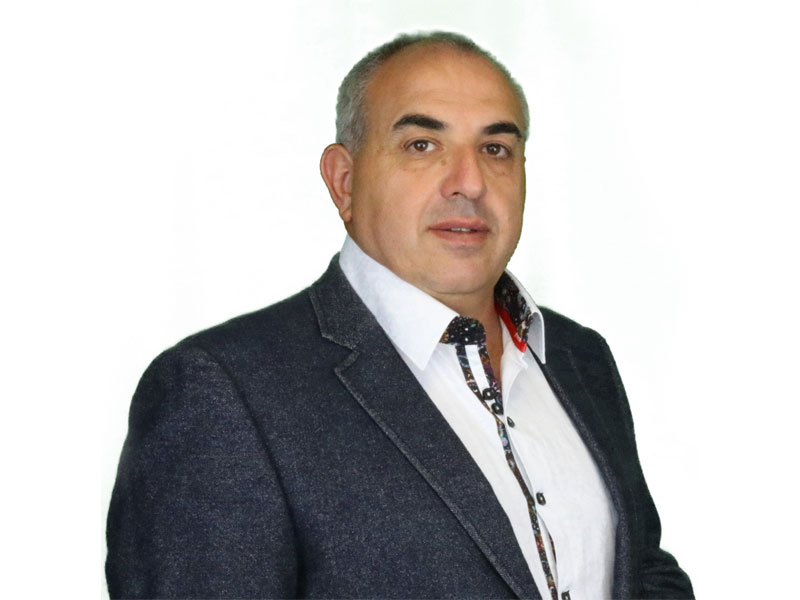Jack Welch is often quoted as saying “The soft stuff is the hard stuff”. There have been many authors who have written about the difficulty of measuring the “soft stuff” in business.
Most organizations have quite extensive financial reporting systems (the hard stuff), whilst very little to report on the journey to excellence (the soft stuff). The most common measure of performance is financial. The challenge with financial measures is that they show a point in time that is often unrelated to the activity that brought the organization to that point. What does that mean? Most businesses have sales cycles that are not instantaneous. Typically, this could be 6-12 months of activity before getting the sale and the corresponding revenue. The financial measures at the end of the sales period reflect activities that took place 6-12 months prior. If there is now a decline in revenue, then actions being taken now may only yield results in 6-12 months’ time. These are often known as lagging indicators due to the time lag between activity and result.
There are three critical components of Excellence in your business context – STRATEGY, LEADERSHIP AND CULTURE. These combine to provide an indicator of the relative position of your organization in journeying on the road to excellence. It is widely acknowledged that perfection is unattainable so excellence is striving to be the best version of yourself every day. The relationship between these is in most organizations is complex with multiple variables and moving parts. One way of understanding the interactions is to compare Excellence in business to a sailing vessel. When you see a sailing vessel moving on the sea it would appear to have wind in its sails, a direction to move and someone steering the ship. This is not unlike business. The vessel would appear to be excellent – making the best of the conditions on that day to be the best version of itself.
The three components are represented by the three intersecting circles of LEADERSHIP, STRATEGY and CULTURE.
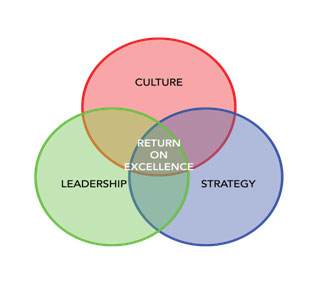
Breaking the individual interactions into separate ideas and reverting back to the analogy of the sailing vessel – consider the interaction between LEADERSHIP and STRATEGY in the absence of a great CULTURE.
When you have great LEADERSHIP combined with a solid STRATEGY and there is a toxic or non-existent CULTURE then you become BECALMED. In sailing terms this is when there is no “wind in your sails”. The greatest ship’s captain can do nothing when there is no wind filling the sails. The vessel is essentially stuck with no way of moving. Extensive research has shown that in the organization, the great leaders with a clear vision and direction
struggle to get organizations moving when the culture is missing or toxic.
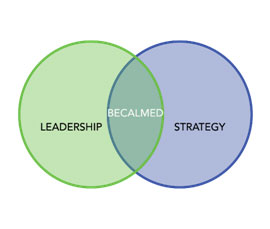
When you have a rich and robust CULTURE and strong LEADERSHIP operating in the absence of a clear STRATEGY then the vessel is DIRECTIONLESS. The STRATEGY component of excellence in an organization is critical as it provides a direction for the team. There is an old saying that says if you “fail to plan then you plan to fail”. Unfortunately, many large organizations tried to make planning a standalone activity unrelated to actual events around them. This led to many “annual strategy” sessions yielding a long-winded plan that gathered dust on employee shelves from year to year whilst management ticked the box to say “strategy done”. STRATEGY in an organization needs to be a living working snapshot of the general direction of movement whilst being flexible and adaptable. Using the sailing vessel idea, and organization operating without a strategy is relying on leadership to steer the ship when they are unsure of the direction in which to head. The last of the three intersections occurs when organizations have a clear STATEGY and a rich and robust CULTURE with an absence of LEADERSHIP. In the sailing vessel terms, this ship
would be rudderless. The team all understand the direction of movement (the STRATEGY) and all buy into the idea (CULTURE) but lack the means to steer the vessel (RUDDERLESS). It is the role of LEADERSHIP to steer the ship in the intended direction whilst following the strategic direction and bringing the team along for the journey. When this is missing, the greatest strategic plan and the most engaging committed teams cannot steer the organization in the correct direction without the input and management of the LEADERSHIP.
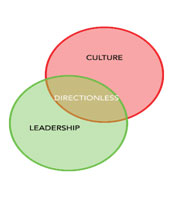
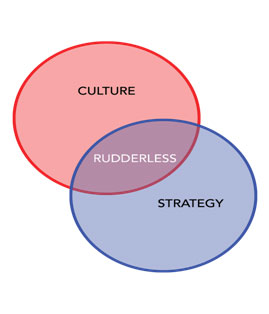
The question of being able to measure these three critical areas of business performance has always been a challenge. Additionally one area of concern is trying to measure something in isolation. Similar to stating a company made $1m profit. Is that good or bad depends on context .If the turnover was $1bn then $1m may not be significant. The second component of measurement is relativity. How does that measurement exist in relation to previous measurements.
In a similar vein measuring the soft stuff needs to be contextual. It requires that the measurement look at an indexation against an ideal and is also checked against trends within the organization.
The last few years have seen the development of a management tool that allows organizations to measure the “soft stuff” and develop an indicator of overall corporate excellence.

This looks at aggregated data across the entire employee group or team. It then considers the areas that the team rate highly and those that the team rate poorly and compares that with an “ideal standard” of 100%. At the ideal – there is no disconnect between the view of the team and an “ideal world” So, in conclusion it is possible to measure the immeasurable and put numbers onto the soft stuff. It requires a mindset shift from traditional focus purely on financial; data to a more forward looking approach of using leading indicators.
About Rael Bricker
From being 6000ft underground in a gold mine, to starting an education business (that grew to have 4000 plus students) to spending years working in venture capital, Rael Bricker has seen it all. He has listed companies on multiple international stock exchanges, and his financial services group has settled more than $3bn in loans over 20 years. Rael has the unique distinction of having sold more than $1bn in mortgages from stage. Rael’s diverse work history combined with unique global research interviews with companies in more than 25 countries allows him to work with leaders and managers on growing and achieving excellence, as he has experienced the rollercoaster himself and knows how to navigate the twists, turns and loops.
If you need Rael to have academic qualifications, he holds two Masters Degrees: an MBA and an MSc (Software Engineering). He is currently a Fellow of the MFAA (Mortgage and Finance Association of Australia), a Certified Speaking Professional (CSP) (Professional Speakers Australia) , Chapter President of PSA (WA) and a Member of AICD (Australian Institute of Company Directors). In 2018, Rael published “Dive in – Lessons learnt since Business School”

